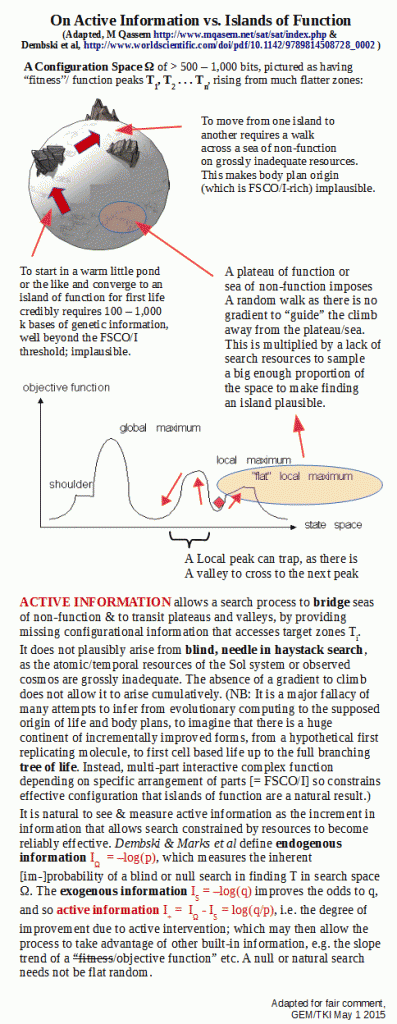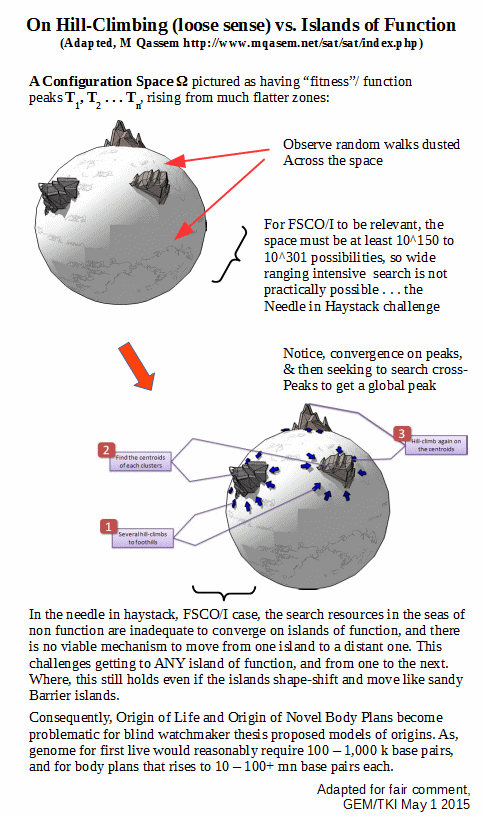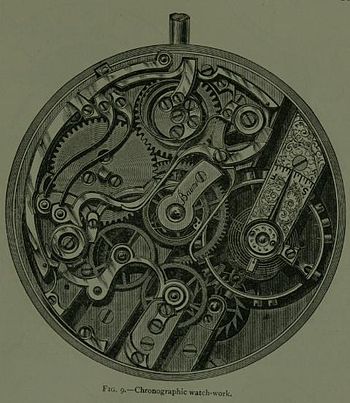One of the common weak arguments against the design inference on functionally specific, complex organisation and/or associated information (FSCO/I, a functional form of specified complexity) is the idea that body-plan level macro-evolution is “simply” the accumulation of lots and lots of micro-evolutionary adaptations in a grand climb of fitness.
It seems to be back on the table, so let us highlight its fundamental flaw through an infographic:

Notice, how easy it is to trap a process that depends on loose-sense hill-climbing.
Where, too, the FSCO/I origin challenge can be similarly summarised:

That fitness peaks will naturally occur as islands of function amidst vast seas of non-function should be obvious from the need for correct, matched, properly arranged and coupled parts to attain relevant, coherent functions. The watch is a classic example:

And, Paley’s observations in Ch 2 of his 1804 Natural Theology on the thought exercise of a self-replicating watch should have been properly addressed by proponents of origin of cell based life and of body plans by incremental, blind watchmaker processes:
NTh, Ch 2: Suppose, in the next place, that the person who found the watch [in a field and stumbled on the stone in Ch 1 just past, where this is 50 years before Darwin in Ch 2 of a work Darwin full well knew about] should after some time discover that, in addition to [–> here cf encapsulated, gated, metabolising automaton, and note, “stickiness” of molecules raises a major issue of interfering cross reactions thus very carefully controlled organised reactions are at work in life . . . ]
all the properties [= specific, organised, information-rich functionality] which he had hitherto observed in it, it possessed the unexpected property of producing in the course of its movement another watch like itself [–> i.e. self replication, cf here the code using von Neumann kinematic self replicator that is relevant to first cell based life] — the thing is conceivable [= this is a gedankenexperiment, a thought exercise to focus relevant principles and issues]; that it contained within it a mechanism, a system of parts — a mold, for instance, or a complex adjustment of lathes, baffles, and other tools — evidently and separately calculated for this purpose [–> it exhibits functionally specific, complex organisation and associated information; where, in mid-late C19, cell based life was typically thought to be a simple jelly-like affair, something molecular biology has long since taken off the table but few have bothered to pay attention to Paley since Darwin] . . . .The first effect would be to increase his admiration of the contrivance, and his conviction of the consummate skill of the contriver. Whether he regarded the object of the contrivance, the distinct apparatus, the intricate, yet in many parts intelligible mechanism by which it was carried on, he would perceive in this new observation nothing but an additional reason for doing what he had already done — for referring the construction of the watch to design and to supreme art [–> directly echoes Plato in The Laws Bk X on the ART-ificial (as opposed to the strawman tactic “supernatural”) vs the natural in the sense of blind chance and/or mechanical necessity as serious alternative causal explanatory candidates; where also the only actually observed cause of FSCO/I is intelligently configured configuration, i.e. contrivance or design]
. . . . He would reflect, that though the watch before him were, in some sense, the maker of the watch, which, was fabricated in the course of its movements, yet it was in a very different sense from that in which a carpenter, for instance, is the maker of a chair — the author of its contrivance, the cause of the relation of its parts to their use [–> i.e. design]. . . . .We might possibly say, but with great latitude of expression, that a stream of water ground corn ; but no latitude of expression would allow us to say, no stretch cf conjecture could lead us to think, that the stream of water built the mill, though it were too ancient for us to know who the builder was. What the stream of water does in the affair is neither more nor less than this: by the application of an unintelligent impulse to a mechanism previously arranged, arranged independently of it and arranged by intelligence, an effect is produced, namely, the corn is ground. But the effect results from the arrangement. [–> points to intelligently directed configuration as the observed and reasonably inferred source of FSCO/I] The force of the stream cannot be said to be the cause or the author of the effect, still less of the arrangement. Understanding and plan in the formation of the mill were not the less necessary for any share which the water has in grinding the corn; yet is this share the same as that which the watch would have contributed to the production of the new watch . . . .
Though it be now no longer probable that the individual watch which our observer had found was made immediately by the hand of an artificer, yet doth not this alteration in anywise affect the inference, that an artificer had been originally employed and concerned in the production. The argument from design remains as it was. Marks of design and contrivance are no more accounted for now than they were before. In the same thing, we may ask for the cause of different properties. We may ask for the cause of the color of a body, of its hardness, of its heat ; and these causes may be all different. We are now asking for the cause of that subserviency to a use, that relation to an end, which we have remarked in the watch before us. No answer is given to this question, by telling us that a preceding watch produced it. There cannot be design without a designer; contrivance, without a contriver; order [–> better, functionally specific organisation], without choice; arrangement, without any thing capable of arranging; subserviency and relation to a purpose, without that which could intend a purpose; means suitable to an end, and executing their office in accomplishing that end, without the end ever having been contemplated, or the means accommodated to it. Arrangement, disposition of parts, subserviency of means to an end, relation of instruments to a use, imply the presence of intelligence and mind. No one, therefore, can rationally believe that the insensible, inanimate watch, from which the watch before us issued, was the proper cause of the mechanism we so much admire in it — could be truly said to have constructed the instrument, disposed its parts, assigned their office, determined their order, action, and mutual dependency, combined their several motions into one result, and that also a result connected with the utilities of other beings. All these properties, therefore, are as much unaccounted for as they were before. Nor is any thing gained by running the difficulty farther back, that is, by supposing the watch before us to have been produced from another watch, that from a former, and so on indefinitely. Our going back ever so far brings us no nearer to the least degree of satisfaction upon the subject. Contrivance is still unaccounted for. We still want a contriver. A designing mind is neither supplied by this supposition nor dispensed with. If the difficulty were diminished the farther we went back, by going back indefinitely we might exhaust it. And this is the only case to which this sort of reasoning applies. “Where there is a tendency, or, as we increase the number of terms, a continual approach towards a limit, there, by supposing the number of terms to be what is called infinite, we may conceive the limit to be attained; but where there is no such tendency or approach, nothing is effected by lengthening the series . . . ,
And the question which irresistibly presses upon our thoughts is. Whence this contrivance and design ? The thing required is the intending mind, the adapted hand, the intelligence by which that hand was directed. This question, this demand, is not shaken off by increasing a number or succession of substances destitute of these properties; nor the more, by increasing that number to infinity. If it be said, that upon the supposition of one watch being produced from another in the course of that other’s movements, and by means of the mechanism within it, we have a cause for the watch in my hand, namely, the watch from which it proceeded — I deny, that for the design, the contrivance, the suitableness of means to an end, the adaptation of instruments to a use, all of which we discover in the watch, we have any cause whatever. It is in vain, therefore, to assign a series of such causes, or to allege that a series may be carried back to infinity; for I do not admit that we have yet any cause at all for the phenomena, still less any series of causes either finite or infinite. Here is contrivance, but no contriver; proofs of design, but no designer. [Paley, Nat Theol, Ch 2]
The unanswered Paley challenge to origin of self-replicating life and to origin of body plans by blind watchmaker incrementalism is on the table. END